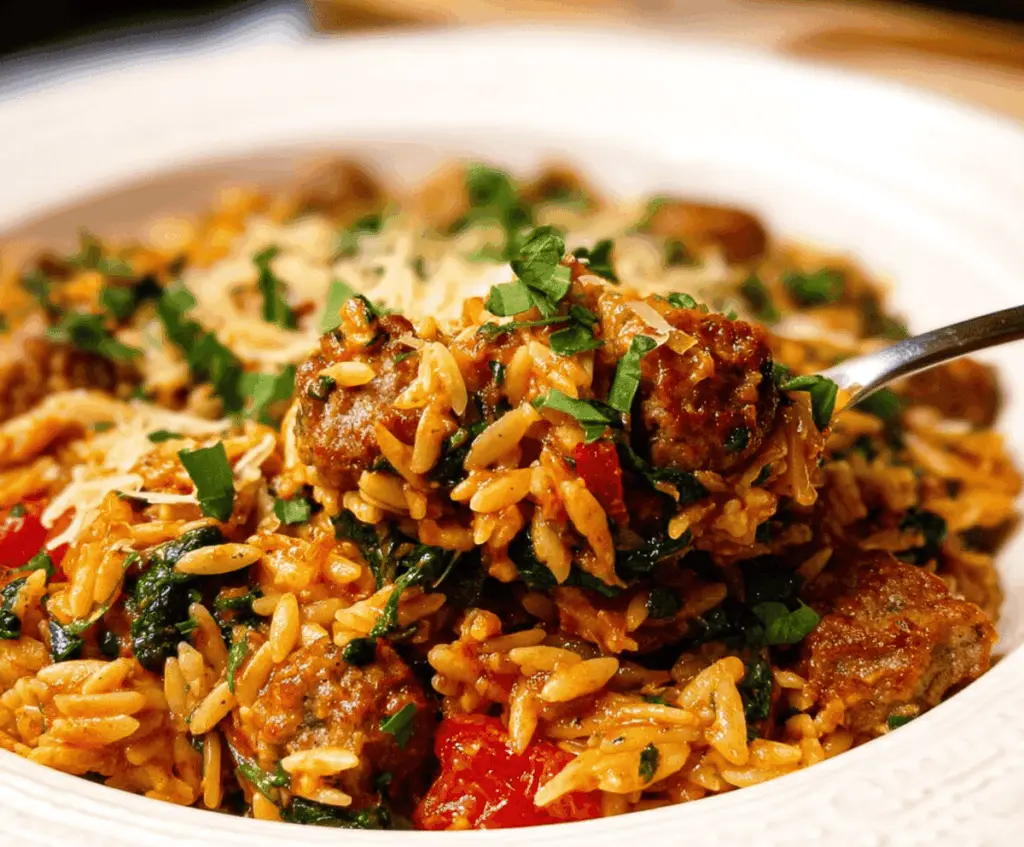
Italian Sausage Orzo
Italian Sausage Orzo is a tasty and comforting dish that brings together hearty Italian sausage with tender orzo pasta, all cooked in a flavorful mix of tomatoes, herbs, and a…
Tip: save now, make later.Italian Sausage Orzo is a tasty and comforting dish that brings together hearty Italian sausage with tender orzo pasta, all cooked in a flavorful mix of tomatoes, herbs, and a bit of cheese. It’s a meal with a nice balance of meaty textures and soft, little pasta that soaks up all the garlicky, herby goodness.
I love making this dish when I want something that feels like a warm hug on a plate but is still quick to prepare. The sausage adds just the right amount of spice, and the orzo is perfect because it cooks fast and makes every bite satisfying. I usually toss in some spinach or bell peppers to add a little color and freshness to the mix.
My favorite way to serve Italian Sausage Orzo is with a simple green salad and crusty bread to soak up any leftover sauce. It’s one of those meals that feels special but doesn’t need a ton of fuss, and I find myself coming back to it again when I want something filling and flavorful. Plus, it reheats great, so there’s always a next-day lunch bonus!

Key Ingredients & Substitutions
Italian Sausage: This is the star of the dish. Mild or spicy both work well. For a lighter option, try turkey or chicken sausage. If you want it vegetarian, use plant-based sausage or mushrooms for a similar texture.
Orzo: Orzo cooks quickly and soaks up the sauce nicely. If you can’t find orzo, small pasta like acini di pepe or even rice can work as substitutes.
Spinach: Fresh spinach adds color and freshness. If you prefer, kale or Swiss chard work well, just cook them a bit longer for tenderness.
Parmesan Cheese: Parmesan adds a salty, nutty finish. If you want a dairy-free alternative, try nutritional yeast or omit it altogether but add a pinch of extra salt to balance flavors.
How Do I Get the Orzo Perfectly Tender Without Overcooking?
The orzo can go from cooked to mushy fast, so watch it closely:
- Toast the orzo in the pan with onions and garlic before adding liquids. This adds flavor and keeps the pasta from becoming slimy.
- Add the broth and tomatoes and simmer gently, stirring occasionally to prevent sticking.
- Check the orzo after 8 minutes by tasting. It should be tender but still have a bit of bite (al dente).
- If it’s not quite done, cover and cook for a few more minutes but keep an eye to avoid overcooking.
Once the orzo is perfectly tender, stir in the spinach quickly so it wilts just right without turning too soft.
Equipment You’ll Need
- Large skillet – perfect for browning sausage and cooking orzo all in one pan, saving you dishes.
- Wooden spoon – helps you stir and scrape the bottom without damaging your skillet.
- Measuring cups and spoons – for accurate liquid and spice amounts that keep the flavors balanced.
- Sharp knife and cutting board – essential for chopping onions, garlic, and spinach safely and easily.
Flavor Variations & Add-Ins
- Swap Italian sausage for ground beef or turkey for a milder flavor and leaner protein.
- Add chopped bell peppers or zucchini with the onions for extra veggies and a bit of crunch.
- Stir in sun-dried tomatoes for a tangy depth that pairs well with the herbs.
- Finish with a sprinkle of mozzarella or fontina cheese for a gooey, melty twist.
How to Make Italian Sausage Orzo?
Ingredients You’ll Need:
- 1 lb Italian sausage (mild or spicy), casings removed and sliced into small rounds
- 1 tablespoon olive oil
- 1 small onion, finely chopped
- 2 cloves garlic, minced
- 1 cup orzo pasta
- 1 can (14.5 oz) diced tomatoes, drained
- 2 cups chicken broth
- 2 cups fresh spinach, chopped
- 1 teaspoon dried oregano
- 1/2 teaspoon dried basil
- Salt and black pepper to taste
- 1/4 cup grated Parmesan cheese
- Fresh parsley, chopped (for garnish)
Time Needed:
This recipe takes about 10 minutes for preparation and around 20 minutes to cook, making it a quick and flavorful meal you can enjoy in about 30 minutes.
Step-by-Step Instructions:
1. Brown the Sausage:
Heat the olive oil in a large skillet over medium heat. Add the sliced Italian sausage and cook it until browned on all sides, about 5-7 minutes. When done, take the sausage out of the skillet and set it aside for later.
2. Cook the Aromatics:
In the same skillet, add the finely chopped onion. Cook it for about 3-4 minutes until it turns translucent. Then add the minced garlic and cook for another 30 seconds, stirring to make sure it doesn’t burn.
3. Toast the Orzo:
Add the orzo pasta to the skillet with the onions and garlic. Stir and toast it for 1-2 minutes to bring out a nutty flavor and prevent sticking later.
4. Add Tomatoes and Broth:
Pour in the drained diced tomatoes and chicken broth. Stir everything well, then bring the mixture to a gentle simmer.
5. Cook the Orzo and Sausage:
Put the browned sausage back into the skillet with the orzo mixture. Cover the pan and let it cook for about 10 minutes. Stir occasionally and check that the orzo is tender and has absorbed most of the liquid.
6. Add Spinach and Season:
Stir in the chopped spinach, dried oregano, and dried basil. Season with salt and pepper to your taste. Cook for another 2-3 minutes until the spinach wilts and softens.
7. Finish With Cheese and Garnish:
Take the skillet off the heat, sprinkle the grated Parmesan cheese over the dish, and stir it in gently. Add fresh chopped parsley on top before serving to add a bit of color and freshness.
Can I Use Frozen Italian Sausage for This Recipe?
Yes, you can! Just make sure to fully thaw the sausage before cooking. Thaw it overnight in the fridge or quickly in a sealed bag submerged in cold water. This helps the sausage cook evenly and prevents excess moisture.
Can I Make Italian Sausage Orzo Ahead of Time?
Definitely! You can prepare the dish up to 2 days in advance. Store it in an airtight container in the fridge, then reheat gently on the stove or microwave. Add a splash of chicken broth if it seems dry while reheating.
What Are Good Substitutions for Orzo?
If you don’t have orzo, small pasta shapes like acini di pepe, couscous, or even rice can work well. Keep in mind that cooking times may vary slightly, so adjust accordingly.
How Should I Store Leftovers?
Keep any leftovers in an airtight container in the refrigerator for up to 3 days. When reheating, stir occasionally and add a little broth or water if needed to keep the dish moist.
